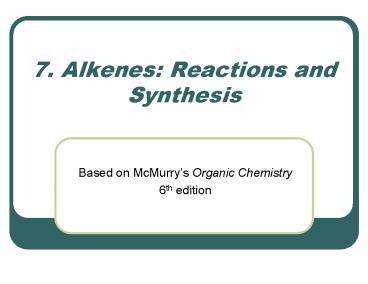7. Alkenes: Reactions and Synthesis - PowerPoint PPT Presentation
1 / 28
Title:
7. Alkenes: Reactions and Synthesis
Description:
Alkenes react with many electrophiles to give useful products by addition (often ... More stable carbocation is consistent with steric preferences. 18 ... – PowerPoint PPT presentation
Number of Views:173
Avg rating:3.0/5.0
Title: 7. Alkenes: Reactions and Synthesis
1
7. Alkenes Reactions and Synthesis
- Based on McMurrys Organic Chemistry
- 6th edition
2
Diverse Reactions of Alkenes
- Alkenes react with many electrophiles to give
useful products by addition (often through
special reagents) - alcohols (add H-OH)
- alkanes (add H-H)
- halohydrins (add HO-X)
- dihalides (add X-X)
- halides (add H-X)
- diols (add HO-OH)
- cyclopropane (add CH2)
3
7.1 Preparation of Alkenes A Preview of
Elimination Reactions
- Dehydrohalogenation
4
7.2 Addition of Halogens to Alkenes
- addition is stereoselective
- Stereoselective reaction a reaction in which one
stereoisomer is formed or destroyed in preference
to all others
5
Mechanism
- Step 1 formation of a bridged bromonium ion
intermediate - Step 2 attack of halide ion from the opposite
side of the three-membered ring
6
- For a cyclohexene, anti coplanar addition
corresponds to trans diaxial addition
7
7.3 Halohydrin Formation
- The actual reagent is the dihalogen (Br2 or Cl2
in water in an organic solvent)
8
Reaction is both regiospecific (anti addition)
and stereoselective (OH to the more substituted
carbon)
9
Mechanism of Formation of a Bromohydrin
Step 1
Step 2
10
An Alternative to Bromine
- Bromine is a difficult reagent to use for this
reaction - N-Bromosuccinimide (NBS) produces bromine in
organic solvents and is a safer source
11
7.4 Addition of Water to Alkenes
Oxymercuration/Reduction
12
Addition of Hg(II) and oxygen is anti
stereoselective
13
7.5 Addition of Water to Alkenes Hydroboration
- Herbert Brown (HB) invented hydroboration (HB)
- Borane (BH3) is a Lewis acid
- Borane adds to an alkene to give an organoborane
14
Hydroboration-Oxidation Forms an Alcohol from an
Alkene
- Addition of H-BH2 (from BH3-THF complex) to three
alkenes gives a trialkylborane - Oxidation with alkaline hydrogen peroxide in
water produces the alcohol derived from the
alkene
15
Orientation in Hydration via Hydroboration
- Regiochemistry is opposite to Markovnikov
orientation - OH is added to carbon with most Hs
- H and OH add with syn stereochemistry, to the
same face of the alkene (opposite of anti
addition)
16
Hydroboration, Electronic Effects give
Non-Markovnikov
- More stable carbocation is consistent with steric
preferences
17
7.6 Addition of Carbenes to Alkenes
- Carbenes are neutral with six electrons in the
outer shell - They symmetrically add across double bonds to
form cyclopropanes
18
Formation of Dichlorocarbene
19
Reaction of Dichlorocarbene
- Addition of dichlorocarbene is stereospecific
20
Simmons-Smith Reaction
21
7.7 Reduction of Alkenes Hydrogenation
- Most alkenes react with H2 in the presence of a
transition metal catalyst to give alkanes - commonly used catalysts are Pt, Pd, Ru, and Ni
- The process is called catalytic reduction or,
alternatively, catalytic hydrogenation
22
Selectivity in Hydrogen Addition
- Selective for CC. No reaction with CO, CN
- Polyunsaturated liquid oils become solids
- If one side is blocked, hydrogen adds to other
23
7.8 Oxidation of Alkenes Hydroxylation and
Cleavage
- Hydroxylation adds OH to each end of CC
- Catalyzed by osmium tetroxide
- Stereochemistry of addition is syn
- Product is a 1,2-dialcohol or diol (also called a
glycol)
24
Examples of Ozonolysis of Alkenes
- Used in determination of structure of an unknown
alkene
25
Structure Elucidation With Ozone
- Cleavage products reveal an alkenes structure
26
Permanganate Oxidation of Alkenes
- Oxidizing reagents other than ozone also cleave
alkenes
27
Cleavage of 1,2-diols
- Reaction of a 1,2-diol with periodic (per-iodic)
acid, HIO4 , cleaves the diol into two carbonyl
compounds - Sequence of diol formation with OsO4 followed by
diol cleavage is a good alternative to ozonolysis
28
Cis-Trans Interconversion in Vision































